ESBM Report: A Comprehensive Analysis of Entrepreneurial Ventures
VerifiedAdded on 2023/04/04
|20
|3748
|415
Report
AI Summary
This report provides an overview of entrepreneurial ventures and typologies. It examines different types of entrepreneurial ventures, including small businesses, scalable startups, large companies, and social enterprises, and explains their relationship to the typology of entrepreneurship, such as survival firms, lifestyle firms, managed growth firms, aggressive growth firms, public sector entrepreneurships, and social enterprises. The report also investigates a range of entrepreneurial ventures in both the public and corporate sectors, highlighting their similarities and differences. Key aspects covered include the characteristics of entrepreneurs, the importance of innovation, and the driving forces behind entrepreneurial activities. The document is available on Desklib, a platform offering study tools and solved assignments for students.
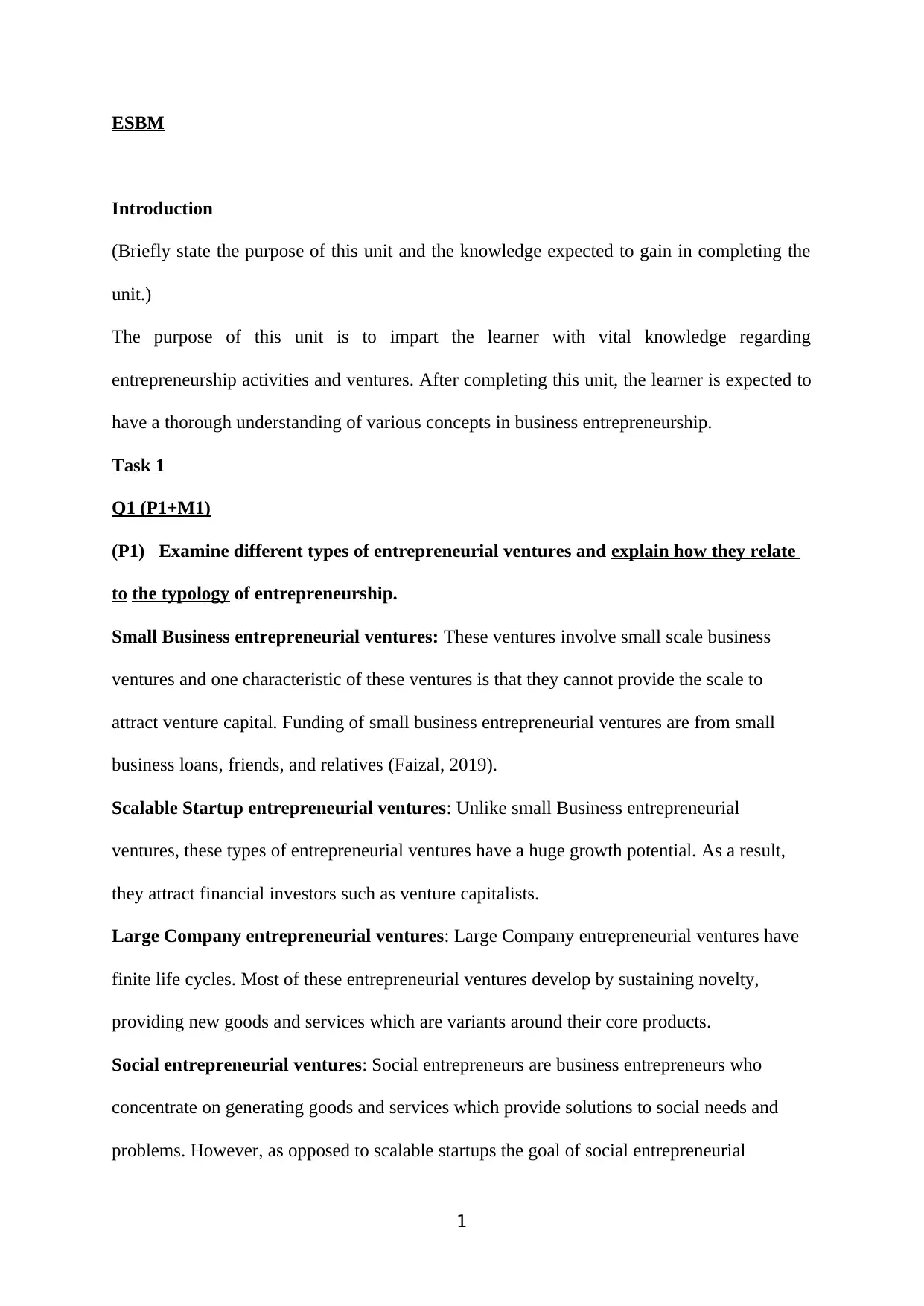
ESBM
Introduction
(Briefly state the purpose of this unit and the knowledge expected to gain in completing the
unit.)
The purpose of this unit is to impart the learner with vital knowledge regarding
entrepreneurship activities and ventures. After completing this unit, the learner is expected to
have a thorough understanding of various concepts in business entrepreneurship.
Task 1
Q1 (P1+M1)
(P1) Examine different types of entrepreneurial ventures and explain how they relate
to the typology of entrepreneurship.
Small Business entrepreneurial ventures: These ventures involve small scale business
ventures and one characteristic of these ventures is that they cannot provide the scale to
attract venture capital. Funding of small business entrepreneurial ventures are from small
business loans, friends, and relatives (Faizal, 2019).
Scalable Startup entrepreneurial ventures: Unlike small Business entrepreneurial
ventures, these types of entrepreneurial ventures have a huge growth potential. As a result,
they attract financial investors such as venture capitalists.
Large Company entrepreneurial ventures: Large Company entrepreneurial ventures have
finite life cycles. Most of these entrepreneurial ventures develop by sustaining novelty,
providing new goods and services which are variants around their core products.
Social entrepreneurial ventures: Social entrepreneurs are business entrepreneurs who
concentrate on generating goods and services which provide solutions to social needs and
problems. However, as opposed to scalable startups the goal of social entrepreneurial
1
Introduction
(Briefly state the purpose of this unit and the knowledge expected to gain in completing the
unit.)
The purpose of this unit is to impart the learner with vital knowledge regarding
entrepreneurship activities and ventures. After completing this unit, the learner is expected to
have a thorough understanding of various concepts in business entrepreneurship.
Task 1
Q1 (P1+M1)
(P1) Examine different types of entrepreneurial ventures and explain how they relate
to the typology of entrepreneurship.
Small Business entrepreneurial ventures: These ventures involve small scale business
ventures and one characteristic of these ventures is that they cannot provide the scale to
attract venture capital. Funding of small business entrepreneurial ventures are from small
business loans, friends, and relatives (Faizal, 2019).
Scalable Startup entrepreneurial ventures: Unlike small Business entrepreneurial
ventures, these types of entrepreneurial ventures have a huge growth potential. As a result,
they attract financial investors such as venture capitalists.
Large Company entrepreneurial ventures: Large Company entrepreneurial ventures have
finite life cycles. Most of these entrepreneurial ventures develop by sustaining novelty,
providing new goods and services which are variants around their core products.
Social entrepreneurial ventures: Social entrepreneurs are business entrepreneurs who
concentrate on generating goods and services which provide solutions to social needs and
problems. However, as opposed to scalable startups the goal of social entrepreneurial
1
Paraphrase This Document
Need a fresh take? Get an instant paraphrase of this document with our AI Paraphraser
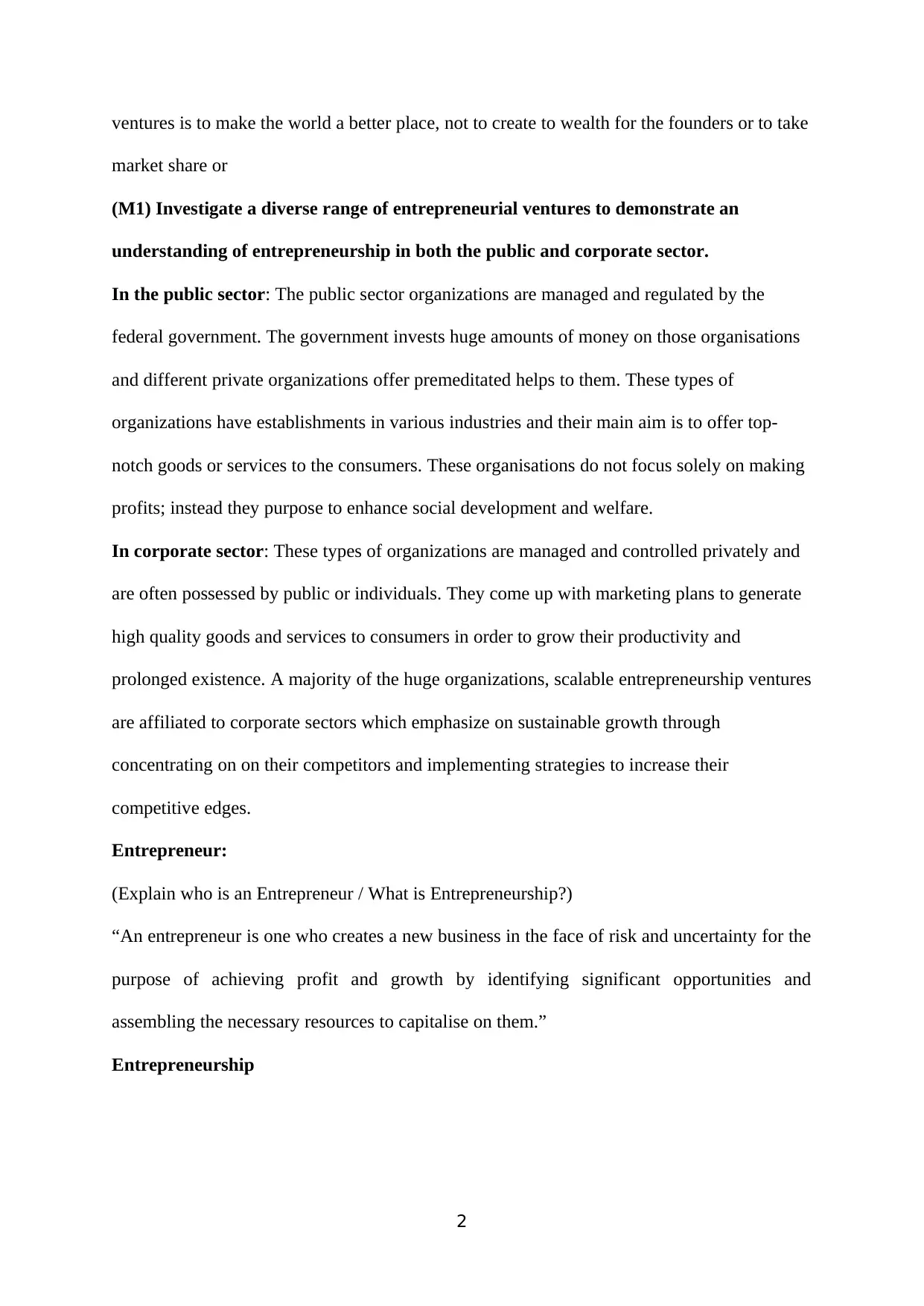
ventures is to make the world a better place, not to create to wealth for the founders or to take
market share or
(M1) Investigate a diverse range of entrepreneurial ventures to demonstrate an
understanding of entrepreneurship in both the public and corporate sector.
In the public sector: The public sector organizations are managed and regulated by the
federal government. The government invests huge amounts of money on those organisations
and different private organizations offer premeditated helps to them. These types of
organizations have establishments in various industries and their main aim is to offer top-
notch goods or services to the consumers. These organisations do not focus solely on making
profits; instead they purpose to enhance social development and welfare.
In corporate sector: These types of organizations are managed and controlled privately and
are often possessed by public or individuals. They come up with marketing plans to generate
high quality goods and services to consumers in order to grow their productivity and
prolonged existence. A majority of the huge organizations, scalable entrepreneurship ventures
are affiliated to corporate sectors which emphasize on sustainable growth through
concentrating on on their competitors and implementing strategies to increase their
competitive edges.
Entrepreneur:
(Explain who is an Entrepreneur / What is Entrepreneurship?)
“An entrepreneur is one who creates a new business in the face of risk and uncertainty for the
purpose of achieving profit and growth by identifying significant opportunities and
assembling the necessary resources to capitalise on them.”
Entrepreneurship
2
market share or
(M1) Investigate a diverse range of entrepreneurial ventures to demonstrate an
understanding of entrepreneurship in both the public and corporate sector.
In the public sector: The public sector organizations are managed and regulated by the
federal government. The government invests huge amounts of money on those organisations
and different private organizations offer premeditated helps to them. These types of
organizations have establishments in various industries and their main aim is to offer top-
notch goods or services to the consumers. These organisations do not focus solely on making
profits; instead they purpose to enhance social development and welfare.
In corporate sector: These types of organizations are managed and controlled privately and
are often possessed by public or individuals. They come up with marketing plans to generate
high quality goods and services to consumers in order to grow their productivity and
prolonged existence. A majority of the huge organizations, scalable entrepreneurship ventures
are affiliated to corporate sectors which emphasize on sustainable growth through
concentrating on on their competitors and implementing strategies to increase their
competitive edges.
Entrepreneur:
(Explain who is an Entrepreneur / What is Entrepreneurship?)
“An entrepreneur is one who creates a new business in the face of risk and uncertainty for the
purpose of achieving profit and growth by identifying significant opportunities and
assembling the necessary resources to capitalise on them.”
Entrepreneurship
2
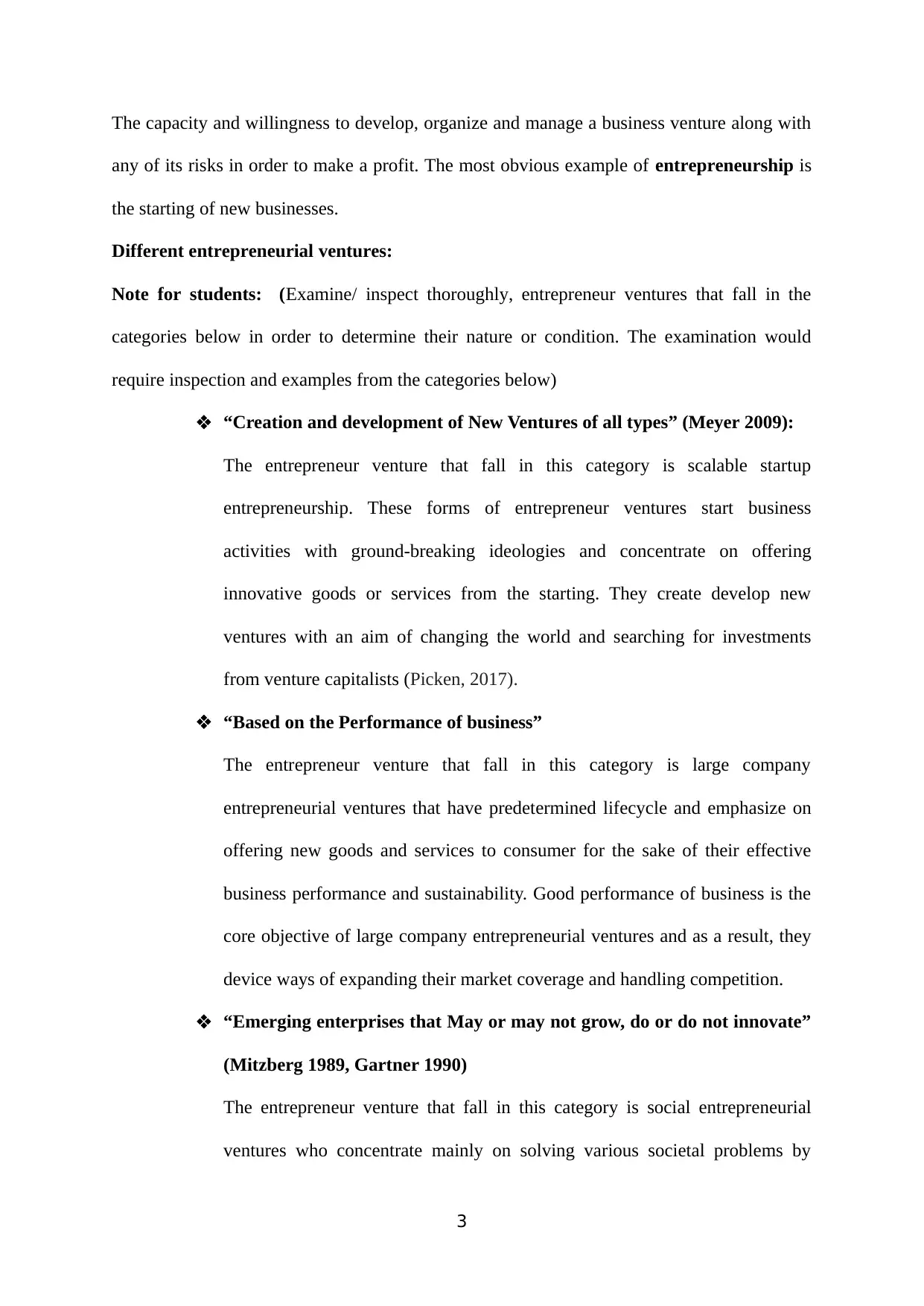
The capacity and willingness to develop, organize and manage a business venture along with
any of its risks in order to make a profit. The most obvious example of entrepreneurship is
the starting of new businesses.
Different entrepreneurial ventures:
Note for students: (Examine/ inspect thoroughly, entrepreneur ventures that fall in the
categories below in order to determine their nature or condition. The examination would
require inspection and examples from the categories below)
“Creation and development of New Ventures of all types” (Meyer 2009):
The entrepreneur venture that fall in this category is scalable startup
entrepreneurship. These forms of entrepreneur ventures start business
activities with ground-breaking ideologies and concentrate on offering
innovative goods or services from the starting. They create develop new
ventures with an aim of changing the world and searching for investments
from venture capitalists (Picken, 2017).
“Based on the Performance of business”
The entrepreneur venture that fall in this category is large company
entrepreneurial ventures that have predetermined lifecycle and emphasize on
offering new goods and services to consumer for the sake of their effective
business performance and sustainability. Good performance of business is the
core objective of large company entrepreneurial ventures and as a result, they
device ways of expanding their market coverage and handling competition.
“Emerging enterprises that May or may not grow, do or do not innovate”
(Mitzberg 1989, Gartner 1990)
The entrepreneur venture that fall in this category is social entrepreneurial
ventures who concentrate mainly on solving various societal problems by
3
any of its risks in order to make a profit. The most obvious example of entrepreneurship is
the starting of new businesses.
Different entrepreneurial ventures:
Note for students: (Examine/ inspect thoroughly, entrepreneur ventures that fall in the
categories below in order to determine their nature or condition. The examination would
require inspection and examples from the categories below)
“Creation and development of New Ventures of all types” (Meyer 2009):
The entrepreneur venture that fall in this category is scalable startup
entrepreneurship. These forms of entrepreneur ventures start business
activities with ground-breaking ideologies and concentrate on offering
innovative goods or services from the starting. They create develop new
ventures with an aim of changing the world and searching for investments
from venture capitalists (Picken, 2017).
“Based on the Performance of business”
The entrepreneur venture that fall in this category is large company
entrepreneurial ventures that have predetermined lifecycle and emphasize on
offering new goods and services to consumer for the sake of their effective
business performance and sustainability. Good performance of business is the
core objective of large company entrepreneurial ventures and as a result, they
device ways of expanding their market coverage and handling competition.
“Emerging enterprises that May or may not grow, do or do not innovate”
(Mitzberg 1989, Gartner 1990)
The entrepreneur venture that fall in this category is social entrepreneurial
ventures who concentrate mainly on solving various societal problems by
3
⊘ This is a preview!⊘
Do you want full access?
Subscribe today to unlock all pages.

Trusted by 1+ million students worldwide
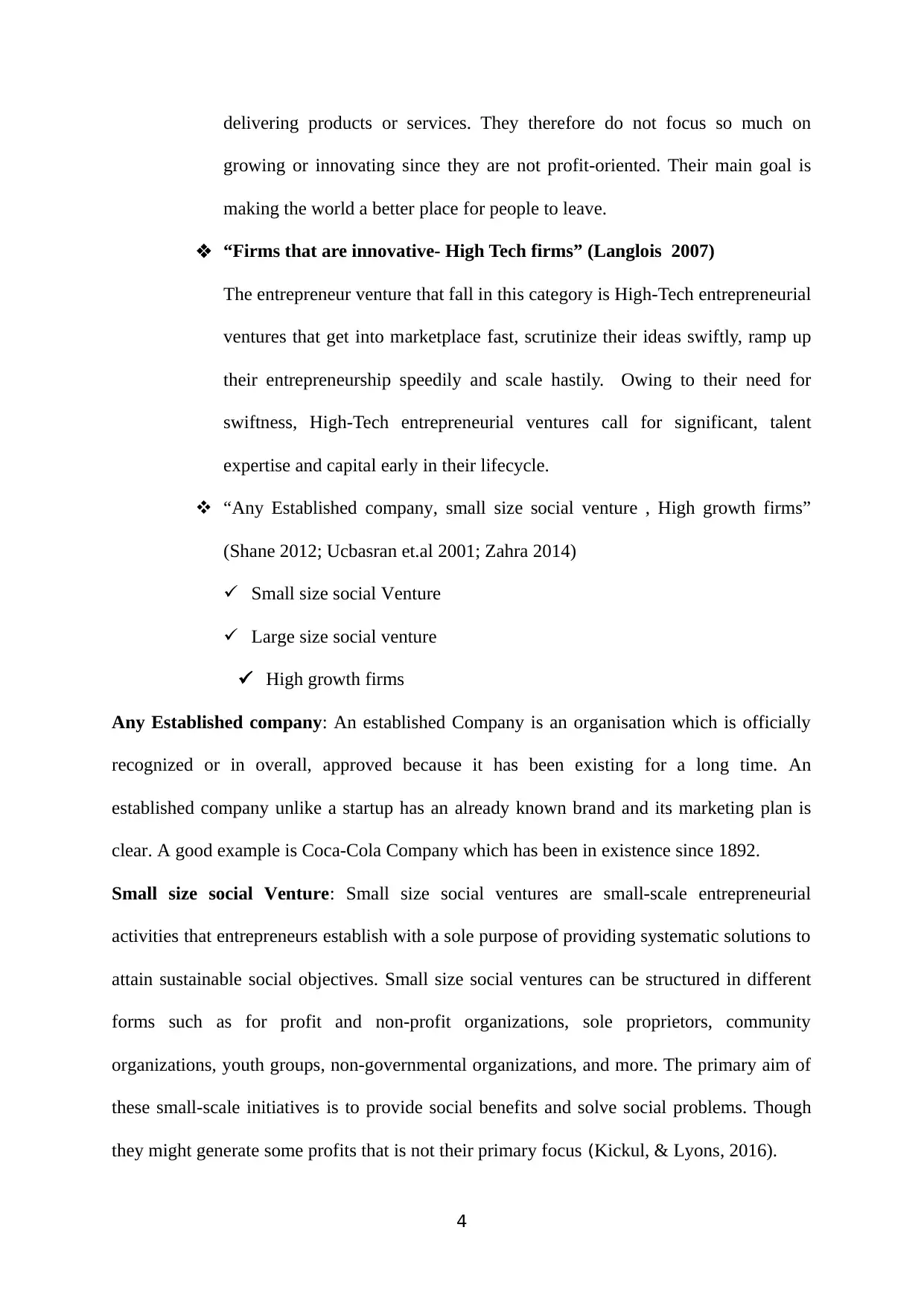
delivering products or services. They therefore do not focus so much on
growing or innovating since they are not profit-oriented. Their main goal is
making the world a better place for people to leave.
“Firms that are innovative- High Tech firms” (Langlois 2007)
The entrepreneur venture that fall in this category is High-Tech entrepreneurial
ventures that get into marketplace fast, scrutinize their ideas swiftly, ramp up
their entrepreneurship speedily and scale hastily. Owing to their need for
swiftness, High-Tech entrepreneurial ventures call for significant, talent
expertise and capital early in their lifecycle.
“Any Established company, small size social venture , High growth firms”
(Shane 2012; Ucbasran et.al 2001; Zahra 2014)
Small size social Venture
Large size social venture
High growth firms
Any Established company: An established Company is an organisation which is officially
recognized or in overall, approved because it has been existing for a long time. An
established company unlike a startup has an already known brand and its marketing plan is
clear. A good example is Coca-Cola Company which has been in existence since 1892.
Small size social Venture: Small size social ventures are small-scale entrepreneurial
activities that entrepreneurs establish with a sole purpose of providing systematic solutions to
attain sustainable social objectives. Small size social ventures can be structured in different
forms such as for profit and non-profit organizations, sole proprietors, community
organizations, youth groups, non-governmental organizations, and more. The primary aim of
these small-scale initiatives is to provide social benefits and solve social problems. Though
they might generate some profits that is not their primary focus (Kickul, & Lyons, 2016).
4
growing or innovating since they are not profit-oriented. Their main goal is
making the world a better place for people to leave.
“Firms that are innovative- High Tech firms” (Langlois 2007)
The entrepreneur venture that fall in this category is High-Tech entrepreneurial
ventures that get into marketplace fast, scrutinize their ideas swiftly, ramp up
their entrepreneurship speedily and scale hastily. Owing to their need for
swiftness, High-Tech entrepreneurial ventures call for significant, talent
expertise and capital early in their lifecycle.
“Any Established company, small size social venture , High growth firms”
(Shane 2012; Ucbasran et.al 2001; Zahra 2014)
Small size social Venture
Large size social venture
High growth firms
Any Established company: An established Company is an organisation which is officially
recognized or in overall, approved because it has been existing for a long time. An
established company unlike a startup has an already known brand and its marketing plan is
clear. A good example is Coca-Cola Company which has been in existence since 1892.
Small size social Venture: Small size social ventures are small-scale entrepreneurial
activities that entrepreneurs establish with a sole purpose of providing systematic solutions to
attain sustainable social objectives. Small size social ventures can be structured in different
forms such as for profit and non-profit organizations, sole proprietors, community
organizations, youth groups, non-governmental organizations, and more. The primary aim of
these small-scale initiatives is to provide social benefits and solve social problems. Though
they might generate some profits that is not their primary focus (Kickul, & Lyons, 2016).
4
Paraphrase This Document
Need a fresh take? Get an instant paraphrase of this document with our AI Paraphraser
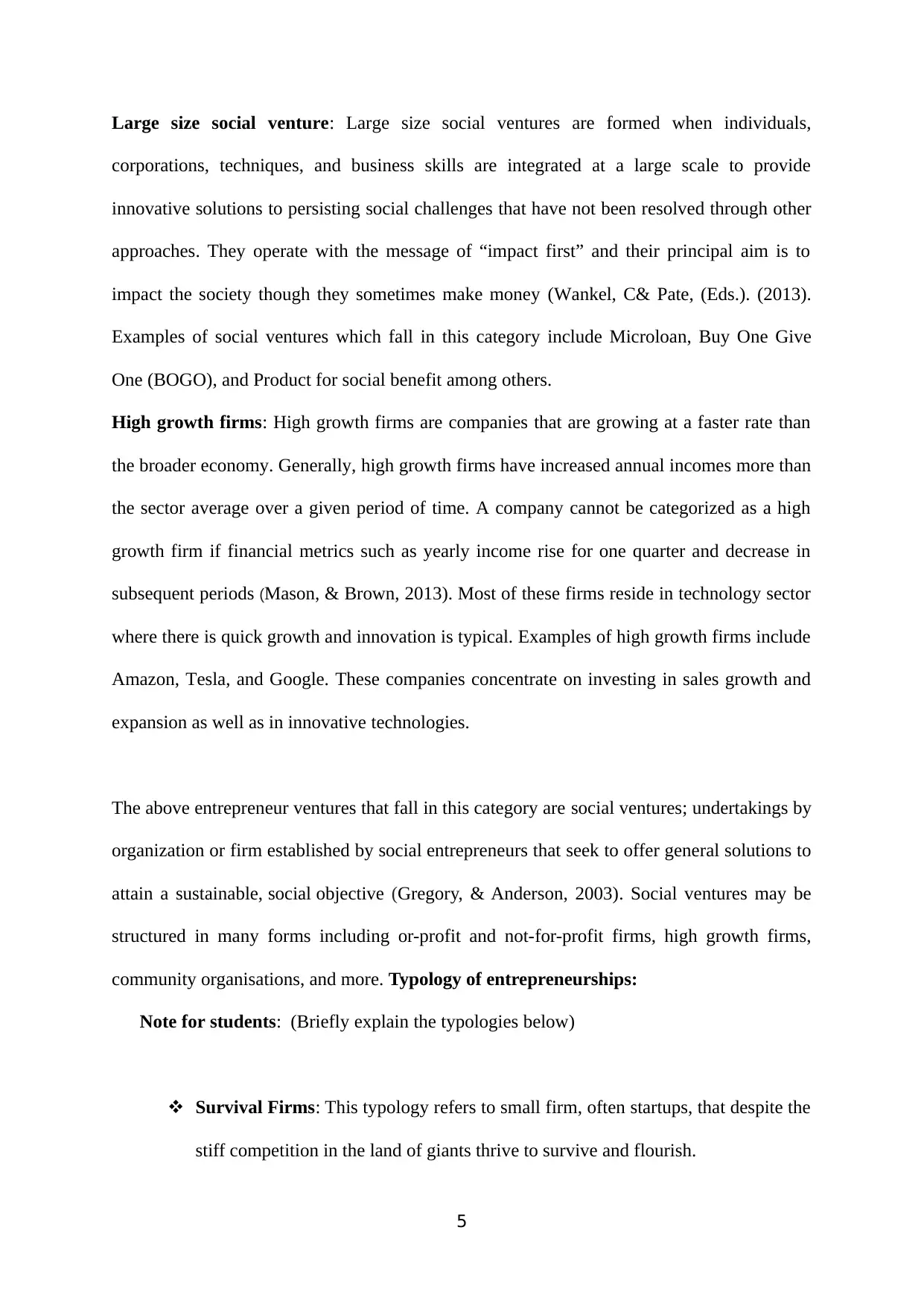
Large size social venture: Large size social ventures are formed when individuals,
corporations, techniques, and business skills are integrated at a large scale to provide
innovative solutions to persisting social challenges that have not been resolved through other
approaches. They operate with the message of “impact first” and their principal aim is to
impact the society though they sometimes make money (Wankel, C& Pate, (Eds.). (2013).
Examples of social ventures which fall in this category include Microloan, Buy One Give
One (BOGO), and Product for social benefit among others.
High growth firms: High growth firms are companies that are growing at a faster rate than
the broader economy. Generally, high growth firms have increased annual incomes more than
the sector average over a given period of time. A company cannot be categorized as a high
growth firm if financial metrics such as yearly income rise for one quarter and decrease in
subsequent periods (Mason, & Brown, 2013). Most of these firms reside in technology sector
where there is quick growth and innovation is typical. Examples of high growth firms include
Amazon, Tesla, and Google. These companies concentrate on investing in sales growth and
expansion as well as in innovative technologies.
The above entrepreneur ventures that fall in this category are social ventures; undertakings by
organization or firm established by social entrepreneurs that seek to offer general solutions to
attain a sustainable, social objective (Gregory, & Anderson, 2003). Social ventures may be
structured in many forms including or-profit and not-for-profit firms, high growth firms,
community organisations, and more. Typology of entrepreneurships:
Note for students: (Briefly explain the typologies below)
Survival Firms: This typology refers to small firm, often startups, that despite the
stiff competition in the land of giants thrive to survive and flourish.
5
corporations, techniques, and business skills are integrated at a large scale to provide
innovative solutions to persisting social challenges that have not been resolved through other
approaches. They operate with the message of “impact first” and their principal aim is to
impact the society though they sometimes make money (Wankel, C& Pate, (Eds.). (2013).
Examples of social ventures which fall in this category include Microloan, Buy One Give
One (BOGO), and Product for social benefit among others.
High growth firms: High growth firms are companies that are growing at a faster rate than
the broader economy. Generally, high growth firms have increased annual incomes more than
the sector average over a given period of time. A company cannot be categorized as a high
growth firm if financial metrics such as yearly income rise for one quarter and decrease in
subsequent periods (Mason, & Brown, 2013). Most of these firms reside in technology sector
where there is quick growth and innovation is typical. Examples of high growth firms include
Amazon, Tesla, and Google. These companies concentrate on investing in sales growth and
expansion as well as in innovative technologies.
The above entrepreneur ventures that fall in this category are social ventures; undertakings by
organization or firm established by social entrepreneurs that seek to offer general solutions to
attain a sustainable, social objective (Gregory, & Anderson, 2003). Social ventures may be
structured in many forms including or-profit and not-for-profit firms, high growth firms,
community organisations, and more. Typology of entrepreneurships:
Note for students: (Briefly explain the typologies below)
Survival Firms: This typology refers to small firm, often startups, that despite the
stiff competition in the land of giants thrive to survive and flourish.
5
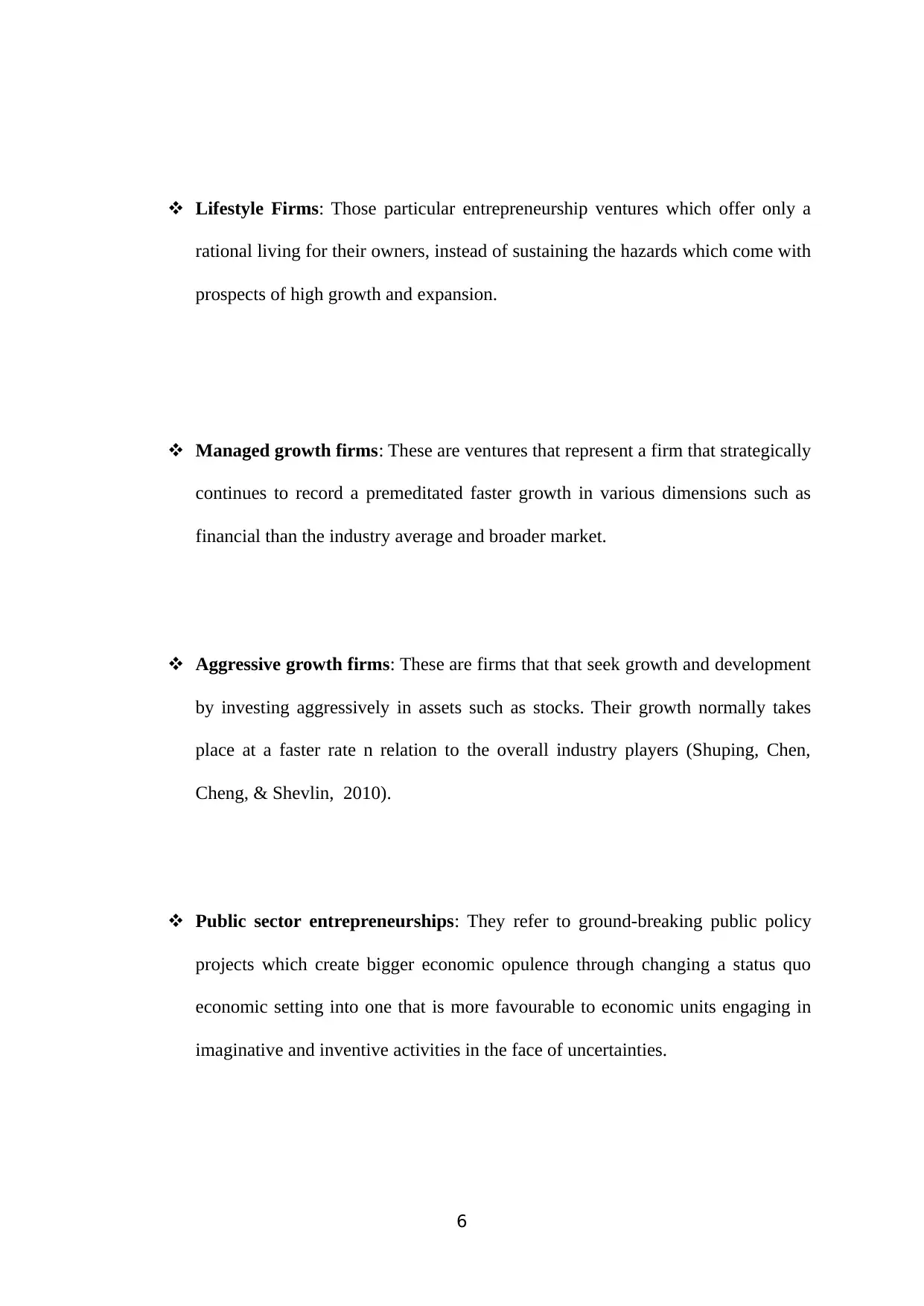
Lifestyle Firms: Those particular entrepreneurship ventures which offer only a
rational living for their owners, instead of sustaining the hazards which come with
prospects of high growth and expansion.
Managed growth firms: These are ventures that represent a firm that strategically
continues to record a premeditated faster growth in various dimensions such as
financial than the industry average and broader market.
Aggressive growth firms: These are firms that that seek growth and development
by investing aggressively in assets such as stocks. Their growth normally takes
place at a faster rate n relation to the overall industry players (Shuping, Chen,
Cheng, & Shevlin, 2010).
Public sector entrepreneurships: They refer to ground-breaking public policy
projects which create bigger economic opulence through changing a status quo
economic setting into one that is more favourable to economic units engaging in
imaginative and inventive activities in the face of uncertainties.
6
rational living for their owners, instead of sustaining the hazards which come with
prospects of high growth and expansion.
Managed growth firms: These are ventures that represent a firm that strategically
continues to record a premeditated faster growth in various dimensions such as
financial than the industry average and broader market.
Aggressive growth firms: These are firms that that seek growth and development
by investing aggressively in assets such as stocks. Their growth normally takes
place at a faster rate n relation to the overall industry players (Shuping, Chen,
Cheng, & Shevlin, 2010).
Public sector entrepreneurships: They refer to ground-breaking public policy
projects which create bigger economic opulence through changing a status quo
economic setting into one that is more favourable to economic units engaging in
imaginative and inventive activities in the face of uncertainties.
6
⊘ This is a preview!⊘
Do you want full access?
Subscribe today to unlock all pages.

Trusted by 1+ million students worldwide

Social enterprise: This is a commercial organisation which has certain social
goals that serve its principal purpose. They try to maximize earnings at the same
time as maximizing benefits to the environment and society.
How they relate to the Typology of entrepreneurships:
Note for students:
Please make sure you cover different type of ventures (minimum 3 to maximum 5 ventures)
from both public and corporate sector. Additionally make sure you cover organisations that
has profit motive (such as: Tesco, Apple, Facebook, Corner shop etc.) also organisations that
has social motives (such as: NHS, funeral care etc).
Different entrepreneurial ventures
as defined by a variety of Authors
Examples in
those
categories
Sector How they relate to the typology of
entrepreneurships
Small business entrepreneurship
travel agents,
consultants,
plumbers,
electricians, h
airdressers,
carpenters,
small
entreprene
urial
sector
Small entrepreneurial ventures can be run by
the owner, family or local employees. Most of
them are barely profitable and their main goal
is to feed the owner not to take over the sector.
Scalable Startup Entrepreneurship
GXpress,
Planet Spark,
Avenue 11,
Samunnati,
and Medika
Startup
Sector
Startups start small with a hope of taking over
the industry in future. They attract venture
capitalists and other investors to invest in their
companies.
7
goals that serve its principal purpose. They try to maximize earnings at the same
time as maximizing benefits to the environment and society.
How they relate to the Typology of entrepreneurships:
Note for students:
Please make sure you cover different type of ventures (minimum 3 to maximum 5 ventures)
from both public and corporate sector. Additionally make sure you cover organisations that
has profit motive (such as: Tesco, Apple, Facebook, Corner shop etc.) also organisations that
has social motives (such as: NHS, funeral care etc).
Different entrepreneurial ventures
as defined by a variety of Authors
Examples in
those
categories
Sector How they relate to the typology of
entrepreneurships
Small business entrepreneurship
travel agents,
consultants,
plumbers,
electricians, h
airdressers,
carpenters,
small
entreprene
urial
sector
Small entrepreneurial ventures can be run by
the owner, family or local employees. Most of
them are barely profitable and their main goal
is to feed the owner not to take over the sector.
Scalable Startup Entrepreneurship
GXpress,
Planet Spark,
Avenue 11,
Samunnati,
and Medika
Startup
Sector
Startups start small with a hope of taking over
the industry in future. They attract venture
capitalists and other investors to invest in their
companies.
7
Paraphrase This Document
Need a fresh take? Get an instant paraphrase of this document with our AI Paraphraser
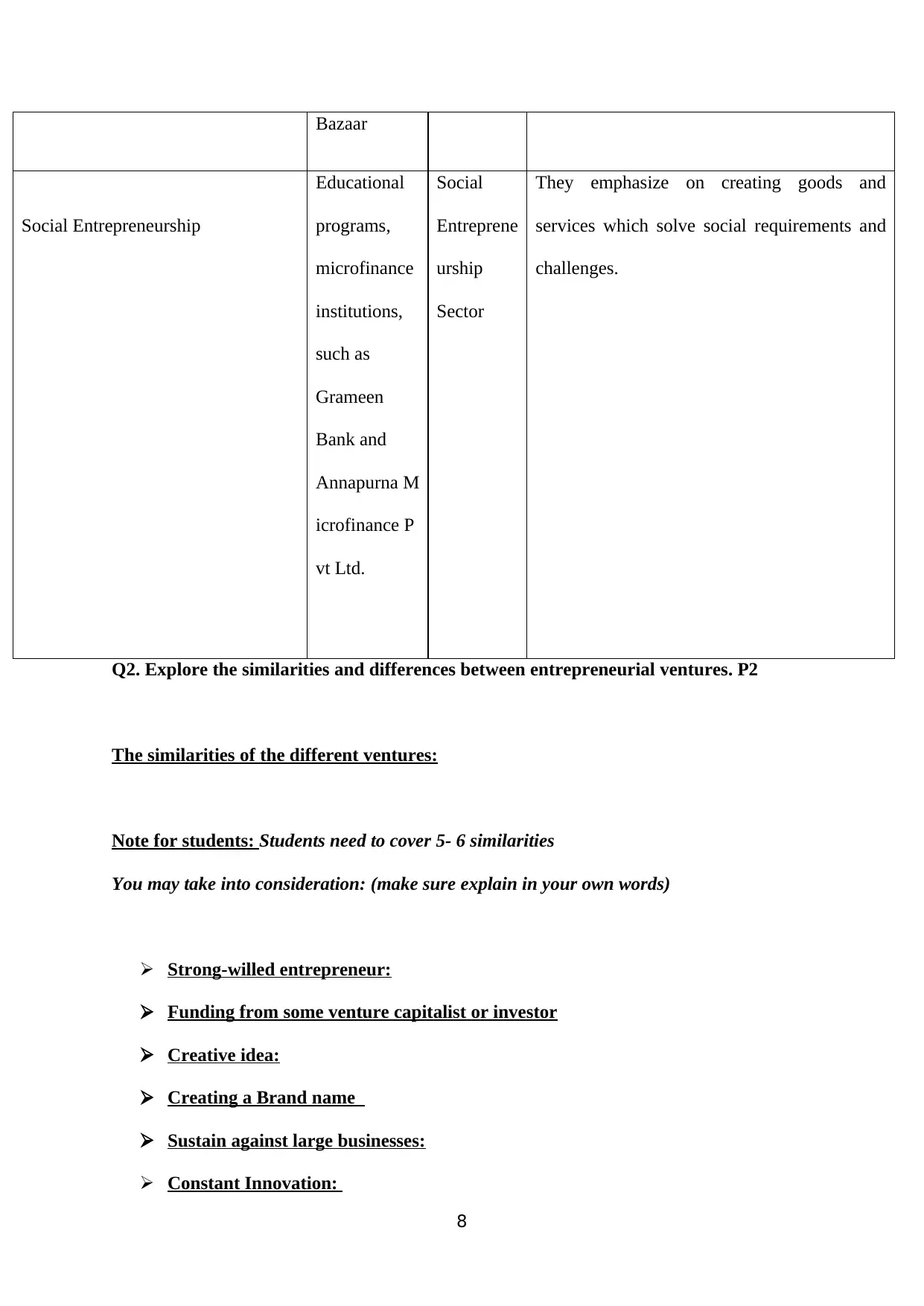
Bazaar
Social Entrepreneurship
Educational
programs,
microfinance
institutions,
such as
Grameen
Bank and
Annapurna M
icrofinance P
vt Ltd.
Social
Entreprene
urship
Sector
They emphasize on creating goods and
services which solve social requirements and
challenges.
Q2. Explore the similarities and differences between entrepreneurial ventures. P2
The similarities of the different ventures:
Note for students: Students need to cover 5- 6 similarities
You may take into consideration: (make sure explain in your own words)
Strong-willed entrepreneur:
Funding from some venture capitalist or investor
Creative idea:
Creating a Brand name
Sustain against large businesses:
Constant Innovation:
8
Social Entrepreneurship
Educational
programs,
microfinance
institutions,
such as
Grameen
Bank and
Annapurna M
icrofinance P
vt Ltd.
Social
Entreprene
urship
Sector
They emphasize on creating goods and
services which solve social requirements and
challenges.
Q2. Explore the similarities and differences between entrepreneurial ventures. P2
The similarities of the different ventures:
Note for students: Students need to cover 5- 6 similarities
You may take into consideration: (make sure explain in your own words)
Strong-willed entrepreneur:
Funding from some venture capitalist or investor
Creative idea:
Creating a Brand name
Sustain against large businesses:
Constant Innovation:
8
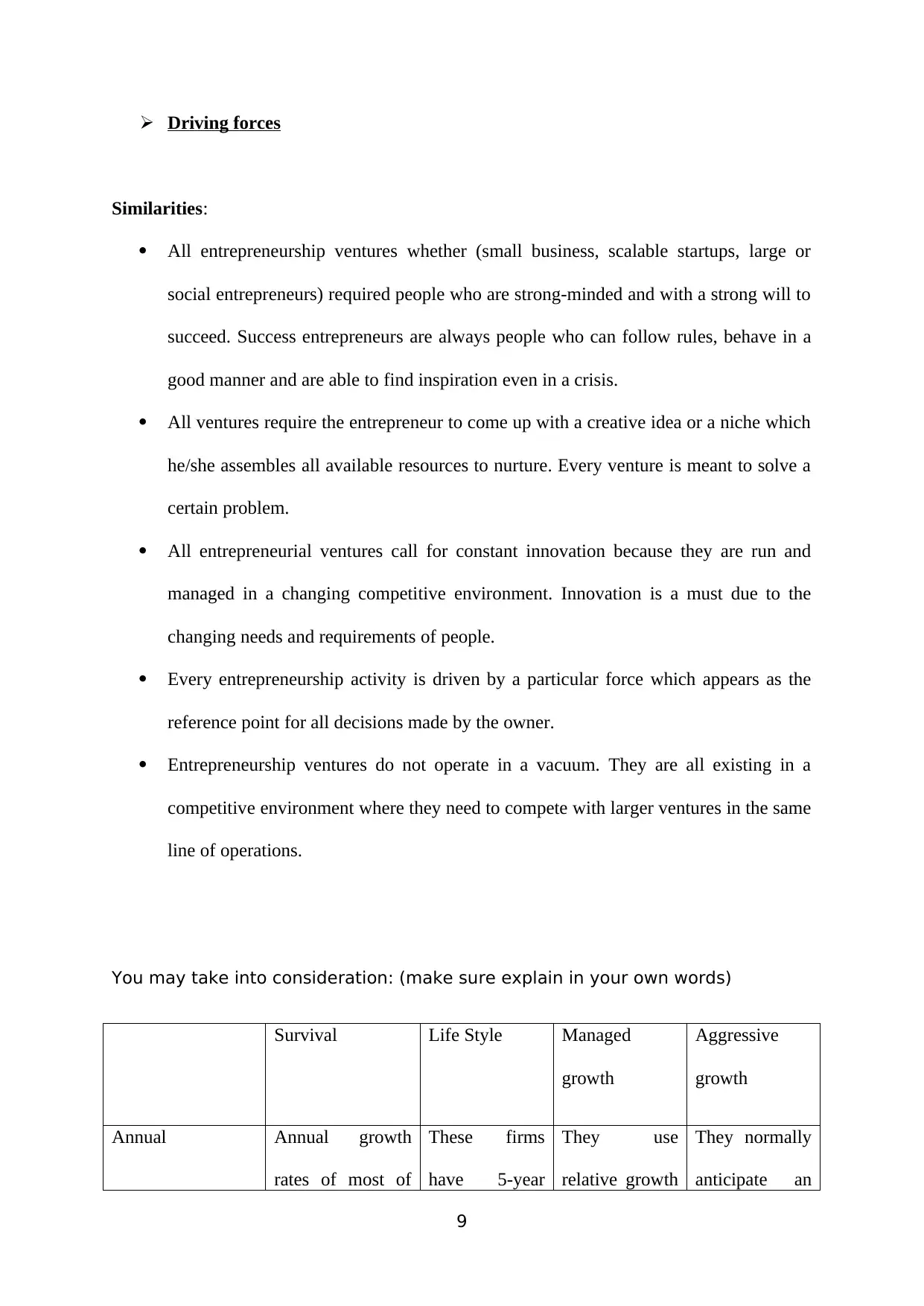
Driving forces
Similarities:
All entrepreneurship ventures whether (small business, scalable startups, large or
social entrepreneurs) required people who are strong-minded and with a strong will to
succeed. Success entrepreneurs are always people who can follow rules, behave in a
good manner and are able to find inspiration even in a crisis.
All ventures require the entrepreneur to come up with a creative idea or a niche which
he/she assembles all available resources to nurture. Every venture is meant to solve a
certain problem.
All entrepreneurial ventures call for constant innovation because they are run and
managed in a changing competitive environment. Innovation is a must due to the
changing needs and requirements of people.
Every entrepreneurship activity is driven by a particular force which appears as the
reference point for all decisions made by the owner.
Entrepreneurship ventures do not operate in a vacuum. They are all existing in a
competitive environment where they need to compete with larger ventures in the same
line of operations.
You may take into consideration: (make sure explain in your own words)
Survival Life Style Managed
growth
Aggressive
growth
Annual Annual growth
rates of most of
These firms
have 5-year
They use
relative growth
They normally
anticipate an
9
Similarities:
All entrepreneurship ventures whether (small business, scalable startups, large or
social entrepreneurs) required people who are strong-minded and with a strong will to
succeed. Success entrepreneurs are always people who can follow rules, behave in a
good manner and are able to find inspiration even in a crisis.
All ventures require the entrepreneur to come up with a creative idea or a niche which
he/she assembles all available resources to nurture. Every venture is meant to solve a
certain problem.
All entrepreneurial ventures call for constant innovation because they are run and
managed in a changing competitive environment. Innovation is a must due to the
changing needs and requirements of people.
Every entrepreneurship activity is driven by a particular force which appears as the
reference point for all decisions made by the owner.
Entrepreneurship ventures do not operate in a vacuum. They are all existing in a
competitive environment where they need to compete with larger ventures in the same
line of operations.
You may take into consideration: (make sure explain in your own words)
Survival Life Style Managed
growth
Aggressive
growth
Annual Annual growth
rates of most of
These firms
have 5-year
They use
relative growth
They normally
anticipate an
9
⊘ This is a preview!⊘
Do you want full access?
Subscribe today to unlock all pages.

Trusted by 1+ million students worldwide

growth Rate the firms
struggling for a
bare survival
ranges from
(startups) is 15% -
45% of year-over-
year growth.
(Steven, &
Conroy, 2016)
revenue
forecasts under
$10 million
and hope for
annual growth
rates in excess
of 50% since
they do not
receive any
funding from
venture
capitalists
rates. This can
be either a
relative growth
rate over time
(for example,
20 percent
annual growth
over a period
of time) or a
growth rate
relative to the
whole
population of
companies in a
sector
annual growth
rate exceeding
the rest in the
overall
industry. They
do not have a
specific rate
but is always
high
comparatively
Time Horizon The length of
time over which
they hold their
investments
before liquidation
differs but unlike
the rest in
survival firms, it
is often longer.
Since the
owners of
lifestyle firms
intend to
sustain a
certain level of
income, their
time horizons
are always
Time horizons
for managed
growth firm
are always
relative to
other
competitors in
the sectors.
Main motive
for aggressive
growth firms is
to grow and
outshine the
rest and
therefore their
investments are
held for a very
10
struggling for a
bare survival
ranges from
(startups) is 15% -
45% of year-over-
year growth.
(Steven, &
Conroy, 2016)
revenue
forecasts under
$10 million
and hope for
annual growth
rates in excess
of 50% since
they do not
receive any
funding from
venture
capitalists
rates. This can
be either a
relative growth
rate over time
(for example,
20 percent
annual growth
over a period
of time) or a
growth rate
relative to the
whole
population of
companies in a
sector
annual growth
rate exceeding
the rest in the
overall
industry. They
do not have a
specific rate
but is always
high
comparatively
Time Horizon The length of
time over which
they hold their
investments
before liquidation
differs but unlike
the rest in
survival firms, it
is often longer.
Since the
owners of
lifestyle firms
intend to
sustain a
certain level of
income, their
time horizons
are always
Time horizons
for managed
growth firm
are always
relative to
other
competitors in
the sectors.
Main motive
for aggressive
growth firms is
to grow and
outshine the
rest and
therefore their
investments are
held for a very
10
Paraphrase This Document
Need a fresh take? Get an instant paraphrase of this document with our AI Paraphraser

The horizon can
even take
decades.
very short. Can
even be
minutes
short period of
time (like
seconds).
Managerial focus Management
focuses solely on
sustaining
survival of the
firm.
Manager’s
primary
purpose is to
sustaining a
certain level of
revenue
Management
emphasizes on
strategic
growth patterns
Management’s
main focus is
to become the
market leader.
Managerial style Administrative
management
styles are highly
applied to ensure
the business lasts
longer in the
sector
Managers use
participative
management
style where
everybody
takes part in
meeting
income goals
of the firm
Extroverted
management
style is used to
ensure
transformation
is achieved in
the entire
organization.
Authoritative
management
style is
commonly
applied
because
managers fear
uncertain and
doubt of
growth
Entrepreneur
orientation
To last as long as
possible in the
competitive
environment
To sustain a
particular level
of income for
the business
To ensure
well-calculated
growth
strategies are
To outshine
and be the best
in a particular
industry
11
even take
decades.
very short. Can
even be
minutes
short period of
time (like
seconds).
Managerial focus Management
focuses solely on
sustaining
survival of the
firm.
Manager’s
primary
purpose is to
sustaining a
certain level of
revenue
Management
emphasizes on
strategic
growth patterns
Management’s
main focus is
to become the
market leader.
Managerial style Administrative
management
styles are highly
applied to ensure
the business lasts
longer in the
sector
Managers use
participative
management
style where
everybody
takes part in
meeting
income goals
of the firm
Extroverted
management
style is used to
ensure
transformation
is achieved in
the entire
organization.
Authoritative
management
style is
commonly
applied
because
managers fear
uncertain and
doubt of
growth
Entrepreneur
orientation
To last as long as
possible in the
competitive
environment
To sustain a
particular level
of income for
the business
To ensure
well-calculated
growth
strategies are
To outshine
and be the best
in a particular
industry
11

in place
Managerial skills Good decision-
making and
problem solving
skills are highly
needed to ensure
the firm survives
successfully in the
market
Managers want
to motivate
their
employees
skilfully in
order maintain
a certain level
of income.
Planning and
communication
skills are very
vital to help the
managers
attain the
growth goals
of the company
Proper
planning and
organization
skills are
paramount to
enable the firm
achieve growth
at faster rates.
Technology
Investment
High investment
in technology and
innovation are
required so as to
be at par with the
market leaders.
Innovations
may not be so
vital provided
the firm is
sustaining its
income levels
High
technological
investment is
very useful
since the firm
intends to
expand in a
strategic
manner.
These firms
invest heavily
in technology
because their
main goal is to
be the leaders
with a short
span of time.
Exit approach These firms
anticipate for a
prolonged
existence and
expect future cash
flows to remain
Assumes that
the firm will be
terminated if it
fails to
generate the
anticipated
Anticipate for
future stable
cash flaws and
stable growth
rate
In most cases
multi-stage
discounted
cash flows are
projected to a
several-year
12
Managerial skills Good decision-
making and
problem solving
skills are highly
needed to ensure
the firm survives
successfully in the
market
Managers want
to motivate
their
employees
skilfully in
order maintain
a certain level
of income.
Planning and
communication
skills are very
vital to help the
managers
attain the
growth goals
of the company
Proper
planning and
organization
skills are
paramount to
enable the firm
achieve growth
at faster rates.
Technology
Investment
High investment
in technology and
innovation are
required so as to
be at par with the
market leaders.
Innovations
may not be so
vital provided
the firm is
sustaining its
income levels
High
technological
investment is
very useful
since the firm
intends to
expand in a
strategic
manner.
These firms
invest heavily
in technology
because their
main goal is to
be the leaders
with a short
span of time.
Exit approach These firms
anticipate for a
prolonged
existence and
expect future cash
flows to remain
Assumes that
the firm will be
terminated if it
fails to
generate the
anticipated
Anticipate for
future stable
cash flaws and
stable growth
rate
In most cases
multi-stage
discounted
cash flows are
projected to a
several-year
12
⊘ This is a preview!⊘
Do you want full access?
Subscribe today to unlock all pages.

Trusted by 1+ million students worldwide
1 out of 20
Related Documents
Your All-in-One AI-Powered Toolkit for Academic Success.
+13062052269
info@desklib.com
Available 24*7 on WhatsApp / Email
![[object Object]](/_next/static/media/star-bottom.7253800d.svg)
Unlock your academic potential
Copyright © 2020–2025 A2Z Services. All Rights Reserved. Developed and managed by ZUCOL.





